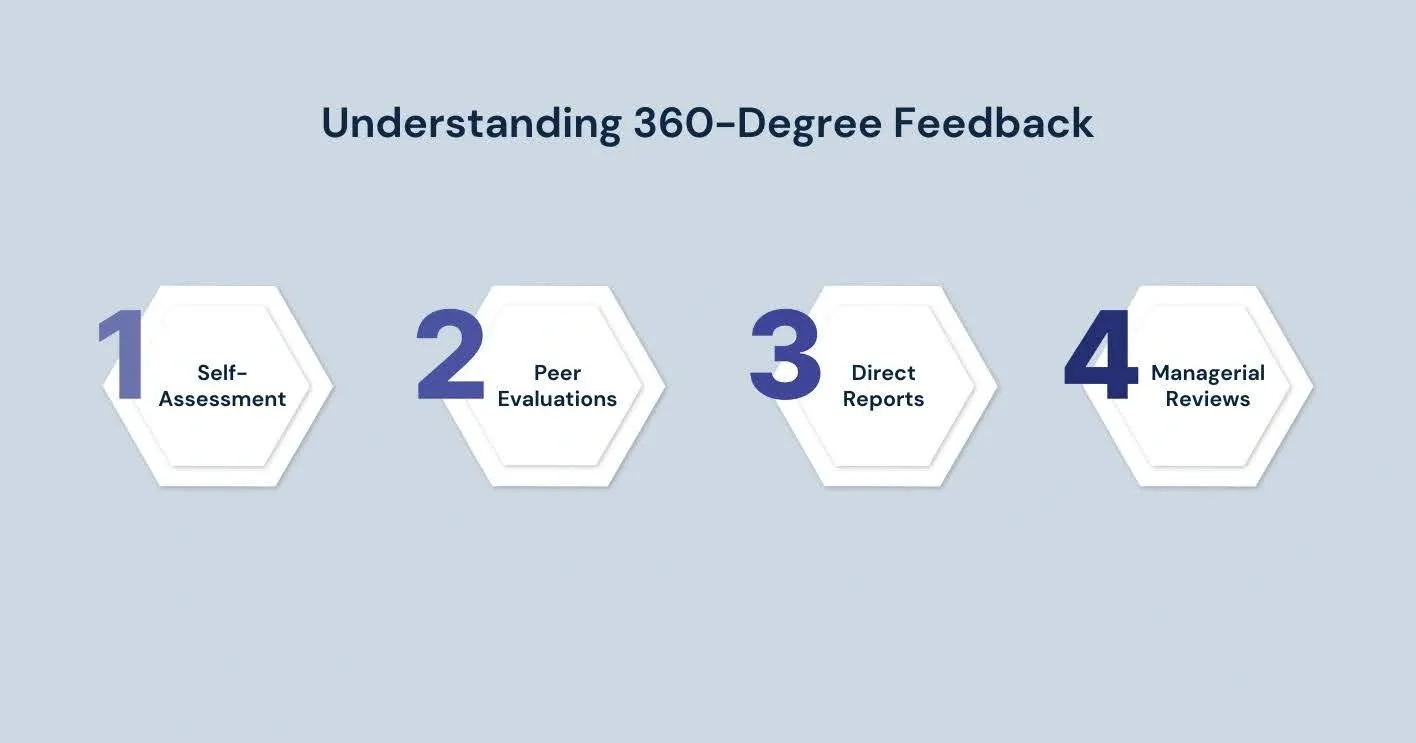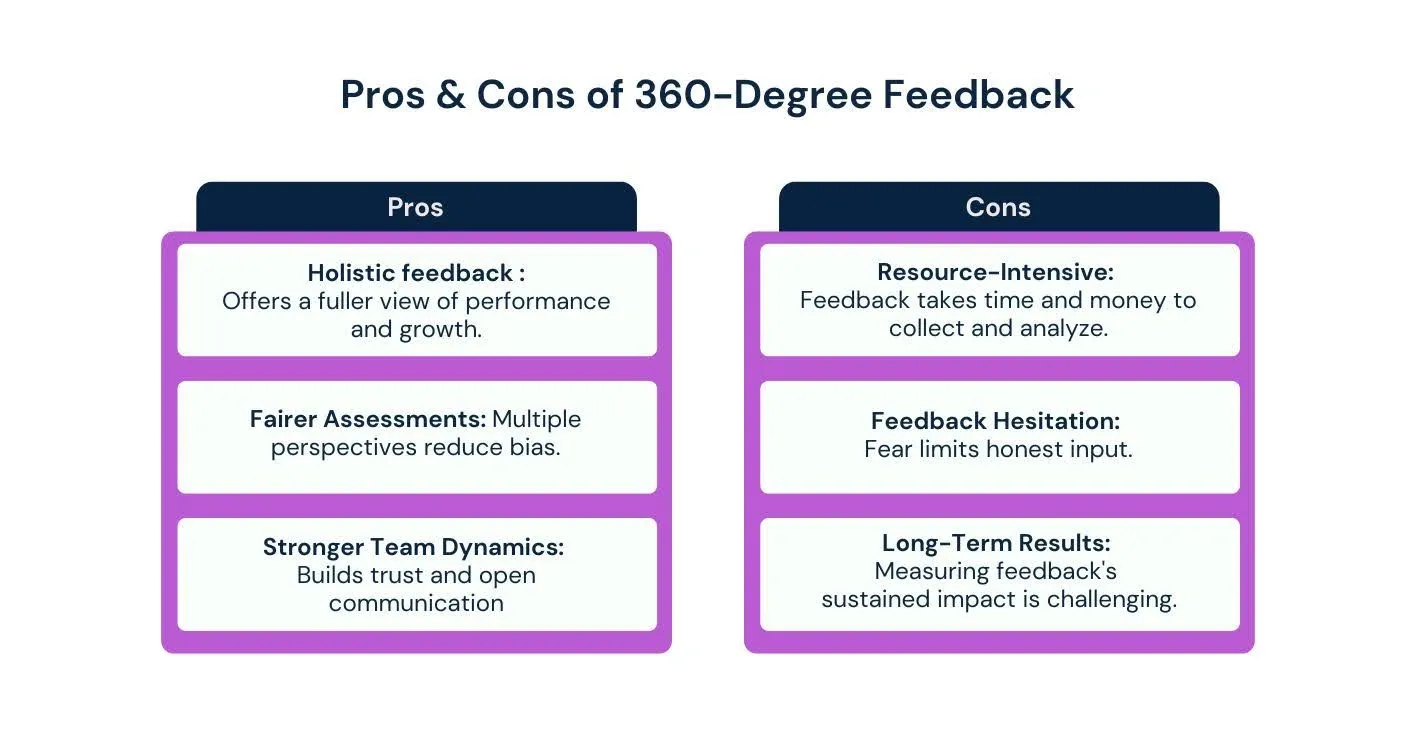
A company is as successful as its single employee. Don’t think of it as an exaggeration. When an employee performs well, the impact ripples through the ranks and leads to the overall growth of the company, and vice versa. HR professionals are already aware that regular employee reviews and feedback are important.
However, when it comes to employee development and performance evaluation, traditional methods often provide a limited view. To get a more comprehensive picture of an employee's strengths, growth areas, and potential, 360-degree feedback is a powerful tool. This holistic approach is designed to capture feedback from multiple sources across the hierarchy, creating a well-rounded perspective. If you’re an HR professional planning to do a 360-degree review of employees, this article is for you. Here’s an in-depth look at how to perform 360-degree feedback, its benefits, challenges, and best practices for both giving and receiving feedback.

A 360-degree review or feedback is a performance evaluation process that gathers input from various sources. Unlike traditional top-down assessments, this method incorporates feedback from the employees themselves, their peers, subordinates, and managers. This allows HR professionals to paint a more detailed picture of an individual’s abilities and performance across different roles and contexts.
For example, at Google, 360-degree feedback plays a significant role in leadership development. The company uses it to assess managers' performance across various levels. This helps identify strong leadership traits and areas for improvement and provides data to help shape training programs. Feedback from peers and team members often uncovers areas where a manager can improve communication or team dynamics, which Google uses to offer targeted leadership coaching. Check out this thread to know how people feel about these reviews.
A 360-degree feedback considers various perspectives to assess an individual’s work behavior, communication style, and leadership potential. This comprehensive approach helps employees understand their strengths and areas for improvement in a way that traditional feedback models can’t. Let’s understand the components of a 360-degree review in more detail. The process involves four main components:
Self-assessment allows employees to reflect on their own performance, identifying strengths and areas for improvement. By evaluating their skills, work habits, and personal traits, employees gain valuable self-awareness, helping them take ownership of their development. It also highlights the gap between self-perception and how others view their performance, providing a foundation for constructive feedback.
Peers offer insights into an employee’s teamwork, communication, and collaboration. As colleagues who work closely with the employee, they can assess how well the individual contributes to group efforts, manages relationships, and adapts to different situations. Peer feedback often uncovers strengths in teamwork or areas for improvement in interpersonal dynamics that might not be visible to managers.
Feedback from subordinates evaluates leadership, communication, and management skills. Direct reports provide unique perspectives on how well an employee leads, communicates instructions, and motivates the team. This feedback is crucial for managers to understand how their leadership style is perceived and where they can improve in managing people and driving team success.
Managers assess employees based on performance outcomes, goal achievement, and overall contribution to the team. These reviews focus on how well employees meet objectives, handle challenges, and contribute to the company’s success. Managerial feedback is outcome-oriented and provides insights into how employees can align their efforts with organizational goals and progress in their careers.
These four components together create a 360-degree view of an employee’s performance, fostering deeper understanding and actionable development. Let’s move ahead and take a look at the implementation of such feedback.
Suggested Read: Exploring Different Types and Methods of Performance Appraisal
Successful implementation of 360-degree feedback requires careful planning and thoughtful execution. It's about creating an open, supportive environment where employees can receive constructive feedback that aids in their development. Here’s a step-by-step guide for you to implement 360-degree reviews.
The first step in implementing 360-degree feedback is to clarify its purpose. Are you using it for performance evaluations, leadership development, or to highlight training needs? Defining the goal ensures that the feedback process is focused and aligned with both the individual and organizational objectives.
Choosing the right people to provide feedback is crucial. Typically, feedback should come from managers, peers, subordinates, and occasionally external stakeholders. This mix of perspectives ensures a well-rounded view of the employee’s performance and behavior across different levels and interactions within the organization.
The feedback criteria should be based on competencies that directly relate to your company’s values and goals. These could include communication skills, problem-solving abilities, and team collaboration. Clearly defined criteria ensure that the feedback is both relevant and actionable, guiding meaningful development efforts.
After collecting the feedback, it’s time to analyze it. Look for recurring patterns or themes in the responses. This step helps identify key strengths to be nurtured and areas of improvement that require attention. It allows HRs to focus on what matters most for the employee's growth.
Once feedback is analyzed, create specific, actionable development goals. For example, if the feedback indicates a need for improvement in leadership skills, set clear objectives like mentoring junior staff or attending leadership training. Action plans should be measurable, with a timeline for tracking progress.
Present the feedback to the employee in a way that is both constructive and supportive. Highlight strengths to boost morale and frame areas for development as opportunities for growth. This ensures that the employee feels motivated to improve and knows exactly what steps to take for further development.
If you’re planning to implement 360-degree feedback in your company, here is an example you could follow. General Electric (GE) introduced a 360-degree feedback system as part of its leadership transformation. This feedback system is used to assess not only technical skills but also leadership behaviors, communication, and teamwork. GE uses this feedback to personalize employee development plans and provide managers with insights into their leadership style, promoting growth. For example, if feedback reveals that a manager struggles with emotional intelligence, they are paired with a coach to develop stronger interpersonal relationships and become better leaders.
Now that you’re aware of the whole process, here is a deeper look at the pros and cons of a 360-degree review so that you can be ready for the challenges.
Suggested Read: Creating a Compensation Job Offer Letter: A Template Guide for Every Situation
While implementing 360-degree feedback can be challenging, the benefits it offers are numerous.
One of the major advantages of 360-degree feedback is that it helps employees gain deeper self-awareness. By receiving feedback from multiple sources, employees get a more balanced view of their strengths and weaknesses. This leads to a better understanding of their professional identity and areas where they can focus their development efforts.
Since feedback comes from various sources, a 360-degree review reduces the risk of bias in performance evaluations. Instead of relying on a single manager’s perspective, the process includes input from various colleagues, ensuring a more balanced and fair assessment.
By encouraging feedback from peers and direct reports, 360-degree feedback leads to open communication. It also helps build trust within teams, as employees feel that their voices are heard and their opinions matter. This can improve overall team dynamics and morale.
However, like anything else in the world, it has its problems too. Let’s take a look at the disadvantages of these reviews.
Despite its many advantages, there are some challenges that come with 360-degree feedback.
360-degree feedback requires significant time and resources to implement. Gathering input from multiple sources, analyzing the data, and creating action plans can be a lengthy process. For smaller teams or companies, this is a logistical challenge.
Some employees may not be comfortable providing honest feedback, especially if it’s constructive. Fear of retaliation or damaging relationships can lead to incomplete or vague feedback, which can undermine the effectiveness of the process.
Tracking the impact of 360-degree feedback can be difficult. While employees may show immediate improvements in certain areas, measuring long-term progress and development based on the feedback can be tricky.
Here’s a comparison of the pros and cons of 360-degree feedback.

Moving forward, let’s take a closer look at some examples of a 360-degree review.
Suggested Read: Pay Transparency: Understanding Salaries in the Workplace
Providing specific examples of feedback can help employees understand better how to give and receive feedback effectively. Here are some examples of positive and constructive feedback:
If you’re planning a 360-degree review for your organization, here are some best practices you should follow for better results.
Effective feedback isn’t just about the content; it’s also about the approach. Here are some tips for both giving and receiving feedback:
Be clear and specific about the behavior you are providing feedback on. For example, instead of saying, "You need to improve your communication," try saying, "In our last meeting, I noticed that you were able to explain your point clearly, which helped the team move forward."
While constructive feedback is necessary for growth, it’s equally important to recognize and celebrate strengths. Provide a balanced mix of positive and constructive feedback to ensure employees feel encouraged, not discouraged.
When receiving feedback, it’s important to keep an open mind. Motivate employees to view feedback as a tool for improvement rather than criticism. Actionable development plans should be created based on this feedback to ensure progress.
Provide feedback as close to the event as possible, so it’s fresh in everyone’s mind. Immediate feedback allows employees to make adjustments quickly and reinforces learning while the experience is still relevant.
When giving feedback, avoid making it sound accusatory. Instead, focus on using “I” statements to express your perspective. For example, "I felt the project could have benefited from more collaboration" instead of "You didn’t collaborate enough." This approach reduces defensiveness and encourages open dialogue.
Before we wrap up, here are some questions you can include in your 360-degree review.
360-degree reviews involve a variety of questions that solicit feedback from different sources. Here are some examples of the types of questions to include:
360-degree feedback offers a complete view of an employee’s strengths, weaknesses, and potential by collecting insights from self-assessments, peers, direct reports, and managers. This holistic approach promotes growth, improves team dynamics, and reduces bias in performance evaluations.
While it’s a powerful tool, implementing 360-degree feedback can be time-consuming and resource-intensive. However, the benefits make it invaluable for employee development.
To ensure success, it’s important to follow best practices like providing specific, actionable feedback and maintaining a balanced approach. With careful execution, 360-degree feedback can drive your organization forward.
At CompUp, we simplify the process of implementing 360-degree feedback systems, helping you gather, analyze, and act on valuable insights. Our tailored solutions make it easy to boost employee growth and build a high-performing workforce.
Let us help you streamline your feedback process and drive organizational success. Book a demo today!
1. What is 360-degree feedback?
360-degree feedback is a performance review process that collects input from multiple sources, such as self-assessments, peers, subordinates, and managers, providing a comprehensive view of an employee’s strengths and areas for growth.
2. What are the benefits of 360-degree feedback?
It enhances self-awareness, reduces bias, fosters better team dynamics, and provides a holistic evaluation, helping employees identify strengths and improvement areas for focused development.
3. How do I implement 360-degree feedback?
Start by defining the purpose, selecting feedback providers, and setting clear criteria. After collecting data, analyze it, develop action plans, and deliver feedback constructively.
4. What challenges come with 360-degree feedback?
It can be time-consuming, may face reluctance in providing honest feedback, and can be tough to track long-term progress. Addressing these requires careful planning and open communication.
5. How can I ensure feedback is constructive and actionable?
Make feedback specific, balanced, and focused on behavior. Encourage a growth mindset and follow up with clear, actionable goals and timelines.

Revolutionizing Pay Strategies: Don't Miss Our Latest Blogs on Compensation Benchmarking